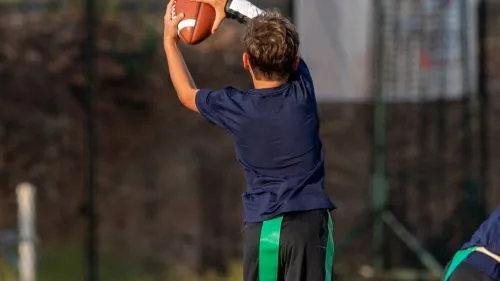Does your child get really frustrated during games? Do they say things like, “I’m just not good at this”?
If so, what you’re seeing is a fixed mindset.
And to see athletes succeed—especially younger athletes—we need to work on developing a growth mindset.
That’s exactly what we’re going to go over in this article.
What Is the Difference Between a Fixed Mindset and a Growth Mindset in Sports?
I’m Eli Straw, a mental performance coach who works with athletes from around the world on building a stronger mental game.
The difference between a fixed mindset and a growth mindset in sports is simple:
-
Fixed Mindset: Says things like, “I’m just not good at this.” It’s the belief that you have to be born with the skill or already be good enough to succeed.
-
Growth Mindset: Sees skills as things we can develop. Mistakes are opportunities to improve. The performance process is seen as a continual journey of getting better—no matter how good we are today.
When a younger athlete develops a growth mindset, they see themselves as athletes who can continually improve. As a result, they not only improve more, but they also have more fun in their sport.
5 Tips to Help Your Young Athlete Develop a Growth Mindset
1. Praise Effort, Not Just Results
A growth mindset views skills and athletic performance as buildable—always growing, always improving.
One of the biggest challenges to a growth mindset is being overly focused on results. This is where perfectionism takes over in younger athletes, making them feel like they have to be perfect today to prove they’re good enough.
When coaches or parents praise only results, it’s easy for a young athlete to connect their worth in the sport solely to the outcome.
Now, at competitive levels—especially as youth sports become more competitive—results matter. We’re not saying results don’t matter, and you should never praise them. But the focal point of your praise should be on effort and the process parts of their game more than the result.
A simple way to guide yourself is to ask: Am I encouraging my younger athlete based on what they can control, or based on things out of their control?
The result is not fully in their control. But effort, attitude, hard work in practice, bouncing back from mistakes, and keeping good body language are in their control. That’s where your praise should live.
2. Normalize Mistakes and Setbacks
Mistakes are inevitable in sports. To “normalize” mistakes doesn’t mean telling your young athlete they should make them—it means helping them understand:
-
Mistakes are normal
-
Mistakes are helpful if we learn from them
-
Mistakes don’t mean they’re not good enough
A fixed mindset says, “If I make mistakes, I’ll never be good at this.” This belief leads to fear of making mistakes, which causes athletes to hold themselves back.
When athletes see mistakes as a natural part of the game and work on learning and improving from them, they become primed to push through and get better because of them.
3. Teach the Power of “Yet”
This goes hand-in-hand with normalizing mistakes.
Help your young athlete reframe their self-talk:
-
“I’m not good at this yet.”
-
“I’m not as strong as I’m going to be yet.”
-
“I’m not as fast as I’m going to be yet.”
The power of yet reinforces the belief that they can improve. Without it, they see things as “I’m good at this” or “I’m not good at this”, which kills motivation.
With a “yet” mindset, they’ll put in more effort and work toward growth.
4. Model a Growth Mindset Yourself
Kids—especially young athletes—tend to adopt the attitudes and mindsets of the adults around them.
If you want your child to have a growth mindset, you need to model it:
-
In how you approach your own sports, fitness, or work
-
In the way you speak about challenges and mistakes
-
In how you praise and encourage them
It’s much easier for a young athlete to adopt a growth mindset when they see you living it.
5. Create a Safe Space for Risk-Taking
For a young athlete to improve, they have to:
-
Push themselves
-
Get out of their comfort zone
-
Try new skills and mechanics
-
Risk failure in the short term
If the environment is filled with judgment, criticism, and frustration over current mistakes, risk-taking disappears.
In my one-on-one coaching, I work with a lot of younger athletes on developing comfort with risk-taking—because without it, growth stalls.
When mistakes are seen as purely negative, and they lead to coaches yelling or parents showing disappointment, the athlete will play timid and hold back. That’s never a recipe for peak performance.
Quick Summary of the 5 Tips
To help your young athlete develop a growth mindset:
-
Praise effort, not results.
-
Normalize mistakes—show them mistakes are for learning.
-
Teach the power of yet—they’re not there yet, but they’re working on it.
-
Model the mindset yourself—live the example you want them to follow.
-
Encourage safe risk-taking—remove judgment and fear from the process.
Final Thoughts
Your young athlete has to push themselves, take risks, and accept that mistakes are part of growth. It’s okay for them to make mistakes right now—as long as they’re working to get better.
If you’re interested in a more in-depth and direct approach to helping your young athlete develop a growth mindset—or improve any mental skill—I offer one-on-one coaching for younger athletes.
If you’re interested in learning more about one-on-one coaching for your young athlete, click here to schedule a free introductory coaching call.
I also have an online course specifically for younger athletes titled The Mentally Tough Kid.
Thank you for reading. I hope these tips help you guide your young athlete toward a stronger, more confident mental game.




